My day began at 3 am, when I woke up to wish our students a pleasant flight home. They’re probably in Chicago by now.
Here’s what I did on my own:
My touring began at 8: 15, when I headed for the tram to finish at least three more checklist items in the morning. The first was at the Archaeology 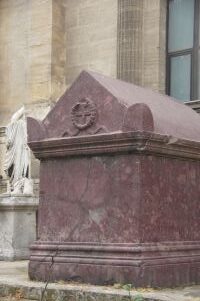 Museum of Istanbul. The guidebooks said it’s a good museum, partly because it doesn’t attract the throngs who flock to the big attractions the way crowds do to the Forbidden City—or the ball games of some teams in Chicago. The information was accurate about the lack of crowds, but the articles on display had some world-class items. The most important (bear in mind the museum has artifacts primarily from within the Ottoman Empire, which included the “Orient”—the Near East) items were sarcophagi from Sidon, which were the reason the Ottomans built the neoclassical museum in the first place. Huge burial boxes, well preserved
Museum of Istanbul. The guidebooks said it’s a good museum, partly because it doesn’t attract the throngs who flock to the big attractions the way crowds do to the Forbidden City—or the ball games of some teams in Chicago. The information was accurate about the lack of crowds, but the articles on display had some world-class items. The most important (bear in mind the museum has artifacts primarily from within the Ottoman Empire, which included the “Orient”—the Near East) items were sarcophagi from Sidon, which were the reason the Ottomans built the neoclassical museum in the first place. Huge burial boxes, well preserved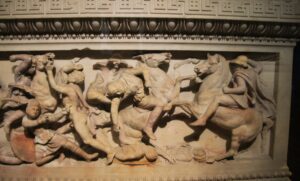 , the tomb with the sculptures of Alexander the Great drawing the most attention; the King buried in it had battled on the side of Alexander, and the frieze commemorates their relationship.
, the tomb with the sculptures of Alexander the Great drawing the most attention; the King buried in it had battled on the side of Alexander, and the frieze commemorates their relationship.
The other outstanding area was a look at Greco-Roman statues, arranged chronologically—all from places that had been either Byzantine or Ottoman, and I’m happy to say that not all the Pergamon relics are in Berlin (and yes, there are some in Pergamon); Turkish antiquities required even in 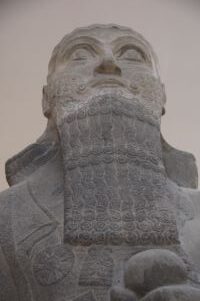 the 19th century that some of the Sidon sarcophagi had to stay where they were. The exhibit on Troy did note part of an ongoing archeological battle over ownership we’d seen elsewhere: that materials in one museum “ought” to be somewhere else—in this case not the New Museum in Berlin! And one exhibit righteously noted that the mosaic, pictured in Istanbul, had been given back to its rightful ruler.
the 19th century that some of the Sidon sarcophagi had to stay where they were. The exhibit on Troy did note part of an ongoing archeological battle over ownership we’d seen elsewhere: that materials in one museum “ought” to be somewhere else—in this case not the New Museum in Berlin! And one exhibit righteously noted that the mosaic, pictured in Istanbul, had been given back to its rightful ruler.
The other part of the museum I especially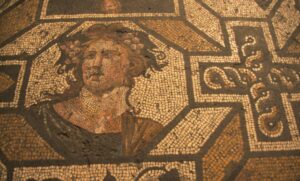 enjoyed was “Istanbul through the Ages,” an exhibit that featured what was and what is, with some wonderful explanations of what happened. I learned, for example, that Bosphorus means “ox ford,” and it came to prominence when Darius and the Persians used a series of boats as a bridge to advance to battle the Greeks; I think one of the monuments to the Greek victory eventually wound up in Istanbul. (Is it time for Greece to get indignant?)
enjoyed was “Istanbul through the Ages,” an exhibit that featured what was and what is, with some wonderful explanations of what happened. I learned, for example, that Bosphorus means “ox ford,” and it came to prominence when Darius and the Persians used a series of boats as a bridge to advance to battle the Greeks; I think one of the monuments to the Greek victory eventually wound up in Istanbul. (Is it time for Greece to get indignant?)
Unfortunately, part of the museum with Byzantine relics was closed—for earthquake proofing (I keep forgetting the Mediterranean is a ring of fire), and perhaps as part of Turkey’s bid for the 2020 Olympics. Actually, it was fortunate, because if the Byzantine materials had been there, I would not have gotten to the other “must sees” on my checklist.
Second on my list for the morning were the Byzantine Cisterns, but on the way, I detoured when I passed Hagia Sophia and saw a sign that said the Sultan tombs were there, and “free.” That’s one of my favorite trigger words, and you don’t see it much in Istanbul (not even special prices for seniors!) There are only a few, but one was designed by Sinan, quickly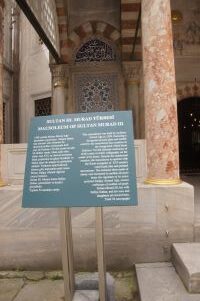 becoming my favorite Ottoman architect; whole families are usually buried together, but Murad (III, I think) had over 100 children; the family had a second tomb with a lot less decoration. Interestingly, one of the tombs occupied the former baptistery.
becoming my favorite Ottoman architect; whole families are usually buried together, but Murad (III, I think) had over 100 children; the family had a second tomb with a lot less decoration. Interestingly, one of the tombs occupied the former baptistery.
One of the tombs had an interesting art story. The Turks shipped the ceramics to France for restoration. The French copied the items and gave the copies to the Turks. The originals are in the Louvre! So much for honor!
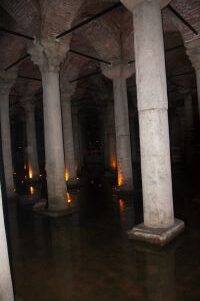 The cool cistern (in more ways than one) was the result of an effort on behalf of the Emperor Justinian to guarantee a water supply for the palace area, obtained from an area 18 miles away via a series aqueducts—another indication of the superior technical state of Byzantium over Western Europe at the time! 520 feet long, 100 feet wide, the “holding tank” is supported by a series of columns that would have done a temple proud. Two pillars had wonderful heads of Medusa –on the bottom, not the top.
The cool cistern (in more ways than one) was the result of an effort on behalf of the Emperor Justinian to guarantee a water supply for the palace area, obtained from an area 18 miles away via a series aqueducts—another indication of the superior technical state of Byzantium over Western Europe at the time! 520 feet long, 100 feet wide, the “holding tank” is supported by a series of columns that would have done a temple proud. Two pillars had wonderful heads of Medusa –on the bottom, not the top.
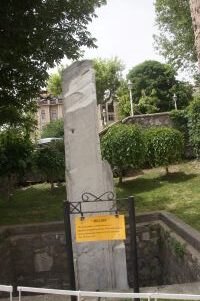
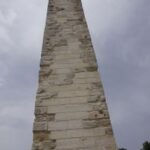 I also wanted to see what was left of the hippodrome, never having spent any time at what was the athletic complex of the Byzantines. What’s left essentially are boundary markers—the Obelisk Theodosius brought from Egypt and the pillar Constantine brought from Delphi. An added treat was finding the “Million”—part of a triumphal arch from which all distances in the Eastern Roman empire were measured.
I also wanted to see what was left of the hippodrome, never having spent any time at what was the athletic complex of the Byzantines. What’s left essentially are boundary markers—the Obelisk Theodosius brought from Egypt and the pillar Constantine brought from Delphi. An added treat was finding the “Million”—part of a triumphal arch from which all distances in the Eastern Roman empire were measured.
For the afternoon, I joined a Grey Line tour going through the former Pera 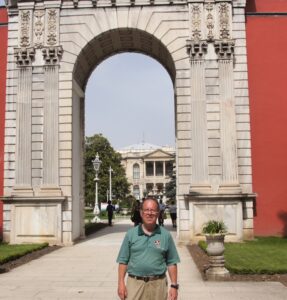 area on the other side of the Golden Horn to the Dolmabahce Palace. I was not prepared for the 1850s neoclassical and rococo palace Abdulhamid built to replace the Topkapi Palace and indicate Turkey was a European power at a time when the Ottomans were desperately trying to modernize to keep the empire together. Greece had already sought its independence; I think Egypt had gotten its; Turkey, England and France were fighting Russia in the Crimea—and Abdulhamid had spent money building a palace that rivaled the big
area on the other side of the Golden Horn to the Dolmabahce Palace. I was not prepared for the 1850s neoclassical and rococo palace Abdulhamid built to replace the Topkapi Palace and indicate Turkey was a European power at a time when the Ottomans were desperately trying to modernize to keep the empire together. Greece had already sought its independence; I think Egypt had gotten its; Turkey, England and France were fighting Russia in the Crimea—and Abdulhamid had spent money building a palace that rivaled the big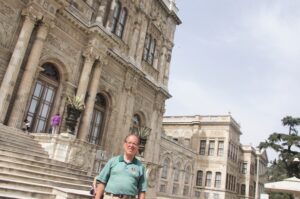 ones in Western Europe. My favorite room reflects the efforts of Germany to woo the Ottomans—a vase from Kaiser Wilhelm, with his picture on it, and a statue and picture of Otto von Bismarck, the German chancellor during the last half of the 19th century, as Germany and the Ottoman Empire forged the ties that helped bind them in a death dance in World War I based on their common enmity to Russia that would topple both the German and Ottoman Empires (as well as their Austro-Hungarian allies)
ones in Western Europe. My favorite room reflects the efforts of Germany to woo the Ottomans—a vase from Kaiser Wilhelm, with his picture on it, and a statue and picture of Otto von Bismarck, the German chancellor during the last half of the 19th century, as Germany and the Ottoman Empire forged the ties that helped bind them in a death dance in World War I based on their common enmity to Russia that would topple both the German and Ottoman Empires (as well as their Austro-Hungarian allies)
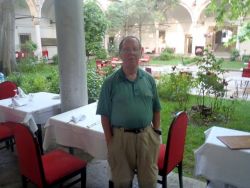 I treated myself to dinner in a restaurant I’d spotted last night in the Suleymaniye mosque area. Adjacent to the mosque, the restaurant was built by noted court architect Mimar Sinan, and the menu featured “Sultan’s Delight,” a lamb and eggplant dish I don’t think I’ve seen at home—but then, we don’t have any Sultans in Bloomington-Normal.
I treated myself to dinner in a restaurant I’d spotted last night in the Suleymaniye mosque area. Adjacent to the mosque, the restaurant was built by noted court architect Mimar Sinan, and the menu featured “Sultan’s Delight,” a lamb and eggplant dish I don’t think I’ve seen at home—but then, we don’t have any Sultans in Bloomington-Normal.